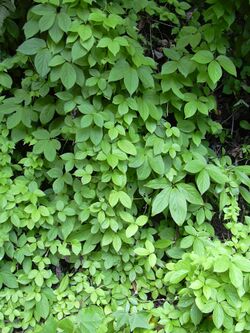Biology:Dioscorea pentaphylla
| fiveleaf yam | |
|---|---|

| |
| Scientific classification | |
| Kingdom: | Plantae |
| Clade: | Tracheophytes |
| Clade: | Angiosperms |
| Clade: | Monocots |
| Order: | Dioscoreales |
| Family: | Dioscoreaceae |
| Genus: | Dioscorea |
| Species: | D. pentaphylla
|
| Binomial name | |
| Dioscorea pentaphylla | |
| Synonyms[1] | |
| |
| Nutritional value per 100 g (3.5 oz) | |
|---|---|
| Energy | 343 kJ (82 kcal) |
20 g | |
0.08 g | |
1.73 g | |
| Vitamins | Quantity %DV† |
| Thiamine (B1) | 7% 0.086 mg |
| Riboflavin (B2) | 1% 0.014 mg |
| Niacin (B3) | 1% 0.13 mg |
| Pantothenic acid (B5) | 10% 0.48 mg |
| Vitamin B6 | 16% 0.209 mg |
| Folate (B9) | 3% 12 μg |
| Minerals | Quantity %DV† |
| Iron | 3% 0.43 mg |
| Magnesium | 3% 10 mg |
| Manganese | 13% 0.283 mg |
| Phosphorus | 6% 40 mg |
| Potassium | 11% 495 mg |
| Sodium | 1% 12 mg |
| Zinc | 3% 0.32 mg |
| |
| †Percentages are roughly approximated using US recommendations for adults. Source: USDA Nutrient Database | |
Dioscorea pentaphylla is a species of flowering plant in the yam family known by the common name fiveleaf yam. It is native to southern and eastern Asia (China , India , Indochina, Indonesia, Philippines , etc.) as well as New Guinea and northern Australia . It is widely cultivated as a food crop and naturalized in Cuba and on several island chains in the Pacific (including Hawaii).[1][2][3][4][5][6][7][8][9][10]
Dioscorea pentaphylla is a prickly vine that twines counterclockwise around objects and other plants. It may reach 10 meters in length. The alternately arranged leaves are compound, divided into 3 to 5 leaflets each up to 10 centimeters long. The plant produces horseshoe-shaped bulbils about a centimeter long. New plants can sprout from the bulbils. Flowers are borne in spikes. The vine grows from a tuber. Specimens may weigh 3 pounds and may be located over a meter underground.[2]
The tubers of the vine can be cooked and eaten.[11]
References
- ↑ 1.0 1.1 Kew World Checklist of Selected Plant Families
- ↑ 2.0 2.1 Gucker, Corey L. 2009. Dioscorea spp. In: Fire Effects Information System, [Online]. U.S. Department of Agriculture, Forest Service, Rocky Mountain Research Station, Fire Sciences Laboratory.
- ↑ Flora of China, Vol. 24 Page 289, 五叶薯蓣 wu ye shu yu, Dioscorea pentaphylla Linnaeus, Sp. Pl. 2: 1032. 1753.
- ↑ Smith, A.C. (1979). Flora Vitiensis Nova. A new flora for Fiji (Spermatophytes only) 1: 1-495. Pacific Tropical Botanical Garden, Lawai.
- ↑ Morat, P. & Veillon, J.-M. (1985). Contributions à la conaissance de la végétation et de la flore de Wallis et Futuna. Bulletin du Muséum National d'Histoire Naturelle. Section B, Adansonia 7: 259-329.
- ↑ Tanaka, N., Koyama, T. & Murata, J. (2005). The flowering plants of Mt. Popa, central Myanmar - Results of Myanmar-Japanese joint expeditions, 2000-2004. Makinoa 5: 1-102.
- ↑ Samanta, A.K. (2006). The genus Dioscorea L. in Darjeeling and Sikkim Himalayas - a census. Journal of Economic and Taxonomic Botany 30: 555-563.
- ↑ Govaerts, R., Wilkin, P. & Saunders, R.M.K. (2007). World Checklist of Dioscoreales. Yams and their allies: 1-65. The Board of Trustees of the Royal Botanic Gardens, Kew.
- ↑ Wilkin, P. & Thapyai, C. (2009). Flora of Thailand 10(1): 1-140. The Forest Herbarium, National Park, Wildlife and Plant Conservation Department, Bangkok.
- ↑ Acevedo-Rodríguez, P. & Strong, M.T. (2012). Catalogue of seed plants of the West Indies. Smithsonian Contributions to Botany 98: 1-1192.
- ↑ Dioscorea pentaphylla. University of Michigan Ethnobotany.
External links
Wikidata ☰ Q5279590 entry
 |

